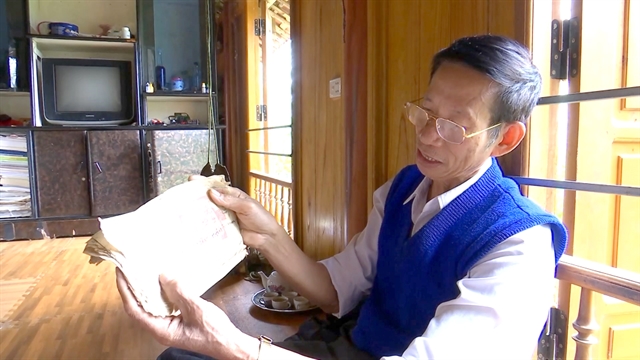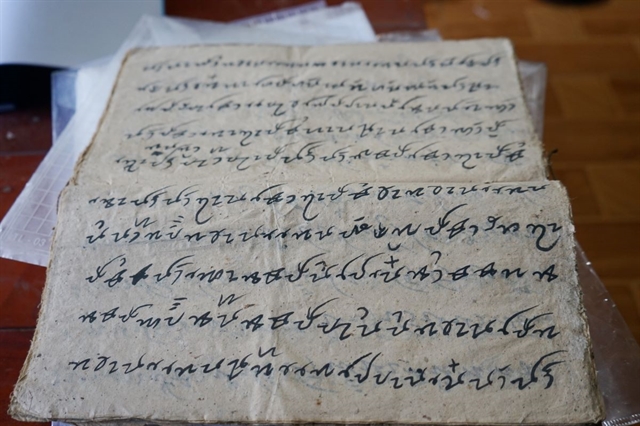 Life & Style
Life & Style

 |
| Hà Nam Ninh shows an ancient book written in Thái script. — VNA/VNS Photo |
THANH HÓA — Hà Nam Ninh, a 76-year-old Thái man in the northern province of Thanh Hóa, has dedicated his life to preserving the ancient Thái (Tai Viet) script, amassing an extensive archive of historical documents written in the endangered language.
Born in 1949, Ninh grew up speaking the Thái language and learning about his ethnic group’s culture and traditions. However, like most people in his community, he could neither read nor write the Thái script.
"When I became a teacher, I asked myself why I, as a Thái person, couldn’t read or write my language. That question drove me to learn. But at first, I didn’t know where to start," Ninh recalled.
His journey began in 1985 when he met Hà Văn Ban, then vice chairman of the Thanh Hóa Provincial People’s Committee and a researcher of Thái culture.
Ban expressed pride in the Thái people’s unique language and script, a rarity among Việt Nam’s ethnic minorities, but lamented that few could still write it.
"Ban asked if I knew the Thái script. When I said no, he scolded me, saying it was unacceptable for a Thái person not to know their writing. He then wrote down the Thái alphabet for me," Ninh said.
Motivated by this encounter, Ninh quickly mastered the script and began collecting historical documents in the Thái language. He was shocked to learn that only 19 people in the province could write the script, most of whom were elderly veterans or cultural artisans.
"How can the Thái people understand their roots if they don’t know their own script?" Ninh wondered.
Over four decades, Ninh has gathered a treasure trove of Thái language materials, including land boundary records, community histories, genealogies and folklore.
Among his most prized possessions is the ancient Thái poem The Journey to Heaven, dating back to King Lê Chiêu Tông's reign (1516–1522). He has also collected other Thái literary works, such as Khăm Panh and Sống Chụ Son Sao, as well as extensive documentation of traditional festivals and customs.
In 2006, Ninh was certified by Thanh Hóa's Department of Education and Training to teach the Thái script. He launched his first class in his hometown, sparking a movement to revive the script in Bá Thước District. Since then, he has expanded his classes to other communes, including Lũng Niêm, Ban Công and Kỳ Tân.
 |
| The Thái (known in English as Tai Viet) script. — Photo laodong.vn |
Ninh’s teaching goes beyond literacy, incorporating practical, culturally relevant content to make the language more accessible.
"The demand was huge, but there were no other teachers of the ancient Thái script in Thanh Hóa back then," he said.
In 2007, Ninh was invited to teach Thái to 13 lecturers at Hồng Đức University, laying the groundwork for a provincial initiative to promote the language.
Today, despite his advanced age, he continues to teach at the university’s Department of Linguistics and collaborates with local authorities to offer classes for officials working in Thái-inhabited areas.
Ninh’s students can typically read, write and communicate in Thái within 20 days. To prepare his lessons, he has travelled extensively across Thái communities in Thanh Hóa, studying regional linguistic and cultural variations.
His efforts have resulted in key educational materials, such as 'The Ancient Thái Script of Thanh Hóa' and 'Teaching the Thái Language in Việt Nam'.
In 2015, the Government honoured him with the title of 'Outstanding Artisan' for his contributions to preserving and promoting Thái cultural heritage.
"As long as I’m healthy, I’ll keep researching and teaching. This is my way of contributing to my people and preserving the culture our ancestors left us," Ninh said.
Hoàng Trọng Long, a forestry official in Thanh Hóa and one of Ninh’s students, said learning Thái has helped him better understand the local culture and communicate more effectively with ethnic communities.
"Communicating in Thái allows us to better convey policies on forest protection and sustainable development to the local community," Long said.
Despite his age, Ninh remains deeply committed to his mission. In 2022, he was appointed head of a committee to standardise the Thái script, which has proposed adding tonal markers to the alphabet.
"If the Thái script disappears, it would be a great loss," Ninh said. "Our culture is rich and unique, and preserving it is my lifelong passion."
Thanks to his efforts, the number of people in Thanh Hóa who can read the Thái script has grown from 19 in 2006 to over 1,000 today. His work ensures that the ancient language and culture of the Thái people will endure for generations to come. — VNS




